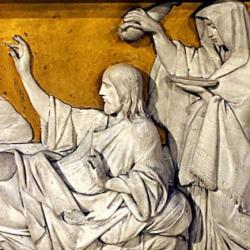In a 2008 article in the Catholic Biblical Quarterly , Catherine Sider Hamilton appeals to the rabbinic legend of Zechariah’s unappeased blood, and from OT texts about the land polluted by blood, to the conclusion that the “traditional” interpretation connecting the blood of Jesus with the destruction of Jerusalem is to a degree correct:
“Matthew, in keeping with the Zechariah legend and the paradigm of bloodguilt and pollution, implies in the people’s cry the devastation of Jerusalem. Blood pollutes the land and so the land is purged. To this extent, the story of innocent blood spells tragedy for the people caught up in it. To this extent, the old and standard reading of the people’s cry is quite correct—not in its universal condemnation of the Jewish people but in its recognition that Matthew hears in this cry the coming desolation. To understand the import of innocent blood in Matthew and the rabbis and the Hebrew Scriptures is to insist on the seriousness of the people’s act of bloodshed—its defiling character and its consequences. There is no miraculous escape, no deus ex machina, for the people in the polluted land. Like the land infected by chamas (‘violence, bloodshed’) in the time of Noah, Jerusalem in the wake of Jesus’ violent death, in the wake of the blood and the blood money that stains the temple, can only be destroyed.”
That’s not, in Hamilton’s view, the end of the story:
“destruction in the Zechariah legends—as in the story of Noah, as in the fulminations of Jeremiah and Ezekiel—does mean purgation. In the severe paradigm of innocent blood, there is still room for hope. After the flood there was a new creation; after the exile, restoration. The blood of Zechariah is swallowed up, in the end, and the wicked Gentile is converted to the faith of the very city he has just destroyed. So, too, I suggest, in Matthew’s blood-haunted narrative. The ironic reading, although it skates over the ominous nature of the people’s act of bloodshed, correctly perceives the promise that is, in the Gospel, intertwined with desolation. It leaps too quickly to restoration, however. The cost of innocent blood is real. Jesus dies and the temple will be destroyed. Yet devastation is not the end of the story. How is the angel’s prophecy of salvation for the people to be fulfilled in the city stained by innocent blood? Matthew points for that fulfillment beyond the people’s choice for bloodshed, to the act of God that follows upon it. At the moment of Jesus’ death, when the temple veil is torn, Matthew adds a curious scene: in an echo of Ezekiel and Daniel, the tombs are opened and the holy ones are raised and enter the holy city. This is new life for the buried saints of Jerusalem, in the holy city itself. This is the ancient hope of Israel for restoration, realized at the heart of Israel, in the death of Jesus. Here, when the earth shakes and the rocks split and the tombs are opened, is the passion narrative’s climax and end. Here, in this proleptic resurrection, the angel’s promise of salvation is realized.”
Innocent blood cannot simply be ignored and forgiven. It has to be purged. ”Destruction and re-creation come together in Matthew’s vision and in the paradigm of innocent blood.” Thus, “As the covenant people take defilement upon themselves, the covenant is made again in the blood of Jesus. As the temple is destroyed, the temple cult is fulfilled in Jesus, in the blood poured out for many for the forgiveness of sins. The city is razed, but it is in the holy city that the risen ones will walk. Jesus’ blood, as Matthew describes it, is poured out not only for the destruction of the covenant people and the temple but for their restoration. This restoration of Israel, however, happens in Jesus. With the destruction of the temple, there is a shift in authority: the authority that belonged to the temple resides now in him and in the community gathered around him. There, ‘where two or three are gathered in my name,’ is now the place of the presence of the Lord.”
Jesus blood redeems by bringing Israel’s history of shedding innocent blood to its climax, and thus fulfilling the doom of the temple. But at the same time, and for the same reason, the blood of Jesus renews. Blood will have blood; innocent blood can only be purged by the blood of the guilty, and He who knew no sin became sin so that He could pay the price of all the innocent blood from Abel to Zechariah.











